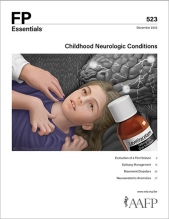
When my youngest son was in high school, he was on the swim team. He told us that whenever he dived off the starting block at the beginning of a race, one hand and one leg would involuntarily spasm, slowing him down for the first few strokes. Since he was in the water by then, this was difficult to observe. However, he began to report that this involuntary movement was happening more frequently. He would get up from the dinner table and say, “There, it just happened again!” but I never had seen it clearly.
We consulted a pediatric neurologist, and the movements occurred when he was asked to move from a chair to the examination table. That was the first time I clearly observed his movement disorder, which turned out to be paroxysmal kinesigenic dyskinesia. This is a rare disorder with brief involuntary attacks that are triggered by voluntary movement.1 Fortunately, his dystonia remains well-controlled with a low dose of carbamazepine (and he gave me permission to share his story with you).
This edition of FP Essentials provides updates on a range of childhood neurologic issues. I hope you find it useful in your practice. Section One provides guidance on the evaluation of a patient with a first childhood seizure. Key elements include determining whether the event was a seizure, and whether it was provoked or unprovoked.
Section Two focuses on management of epilepsy in children, including an overview of epilepsy types and a review of important antiseizure drugs. I particularly was interested to read about the benefits of a ketogenic diet in patients with pharmacoresistant epilepsy. The authors also provide helpful information on how to counsel family members and caregivers about seizure safety, first aid, and drugs for status epilepticus.
Section Three addresses movement disorders in children, with useful sections on the diagnosis and management of tic disorders (including Tourette syndrome), chorea, dystonia, ataxia, and others. Section Four covers neuroanatomic abnormalities that lead to abnormal head shape and size, including craniosynostosis, plagiocephaly, microcephaly, macrocephaly, and hydrocephalus.
When you have finished studying this edition of FP Essentials and are ready to submit your posttest answers, please tell us what was most useful and what we can do to improve. We look forward to hearing your ideas for topics you would like covered in future editions.
Karl T. Rew, MD, Associate Medical Editor
Associate Professor, Departments of Family Medicine and Urology
University of Michigan Medical School, Ann Arbor
